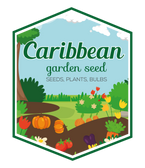
Pepper seeds -Scotch Bonnet, Jamaican Yellow
FAST & FREE SHIPPING
Over 90% of our orders are processed and ship out by next business day.
We are currently processing and shipping most orders within 1-3 business days. (backorders not included) Due to high demand during the peak months of January to May, orders may require additional time for packaging /shipment.
Free shipping for orders over $54.95. Excludes live plants, fresh products And Stackable Black Plastic Nursery Crate
Shipping and handling charges will cover outbound freight and packaging materials. Fees are applicable to all orders, based on total order value pre-tax. Expedited services can be selected at Checkout with extra fees.
- Free shipping to lower 48 states on orders $54.95+
- (Most Items), excluding live plants, plant bulbs, and black plastic nursery crate.
- Safe Seed Pledge
- Satisfaction Guaranteed
- Select your desired size and/or color from the available options.
Authentic and flavorful Jamaican Scotch Bonnet pepper seeds have a distinct taste and are grown on robust plants.
Discover the beloved fiery flavor of the Jamaican pepper, commonly used in Caribbean cuisine for its intense heat. Perfect for jerk dishes like chicken, pork, and shrimp, this pepper is a favorite among food enthusiasts. Beware of its powerful pungency, which may surprise those new to the Scotch Bonnet pepper.
Elevate your Jamaican cuisine with this all-purpose pepper. Ideal for Jerk Pork, Jerk Chicken, as well as curried goat, stews, soups, rice and peas, patties, and peppered shrimp. Its distinct flavor profile adds depth to any dish.
Get ready for ripe Jamaican Yellow Scotch Bonnet peppers! Named for its unique shape resembling a Scottish headdress, these peppers are a must-try for any pepper lover. There are many other peppers of different shapes and colors in Jamaica, but if they do not have the correct shape and colour, they are not Scotch Bonnet.HOW TO
GROWING TIPS
For successful tropical plant growth from seeds, use Organic Seed Starting Material. Avoid jiffy peat pots, plugs, or potting soil for best results. Proper temperature, moisture, and air circulation are crucial. Peppers have varying germination times, typically 1 week to 1 month. Provide warmth for germination, such as a heating mat or warm surface like a fridge. Plan and start early.
TO GROW PEPPER SEEDS
1. where gloves
2.always wash your hands even after you take you gloves off
3.have some lime juice to dump on your hands if they are burning as its said to relieve the burning
4.never rub any sensitive area like your eyes and so forth.
5.before you take your gloves off besure you are completely finished at what you are doing
Sow seeds indoors ¼" deep. Peppers germinate best in warm soil, so gentle bottom heat may be helpful until seedlings emerge. Wait to transplant outdoors until soil is warm .Pepper seeds come from tropical, humid regions and require proper temperature, moisture, and air circulation for optimal growth. Avoid using jiffy peat pots, plugs, or potting soil as they can cause problems with moisture levels and lead to disease and fungus. Organic Seed Starting Material is recommended for optimal germination results..
Growing Hot Peppers in Containers
Peppers can be grown all year long in containers. It is suitable for apartment dwellers and gardeners who live in cool regions where the number of growing days are limited. Many pepper enthusiast grow peppers in pots so they can have fresh peppers all year long. It’s best to use 5 gallon containers so the roots do not get too over-crowded
Soil Requirements: Requires fertile soil in a well drained location in the garden. Apply much and grass clippings, or straw around base of plant.
Water Requirements: Water well with soaker hoses during dry and hot spells.
Fertilizer Requirements: Use Slow Release Fertilizer when transplanting outdoors. Apply Miracle Gro every two weeks.
HOW TO GROW GUIDE
LET OUR CUSTOMER SPEAK FOR US

![[Seeds] - Caribbeangardenseed](http://caribbeangardenseed.com/cdn/shop/files/gift-card-gift-card-1_1024x1024_dfa857db-9150-4315-a362-7f0bb3fb9c47_60x28.png?v=1722895789)








